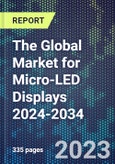Shaping the Future of Displays: Unveiling Breakthroughs, Investments, and Market Dynamics Across Consumer Electronics, Automotive, and More
MicroLED is a self-emitting display consisting of arrays of microscopic LEDs each forming a pixel. MicroLED commercial activity is picking up considerably. Apple has plans to invest>$2 billion establishing smartwatch display production with 8” MicroLED chip fab at ams-Osram. Epistar and AUO are building a 6” MicroLED foundry leveraging PlayNitride technology. AUO will also begin production of a smart watch display 1.39” in Q4 23. Jade Bird Display has commenced it's production line in Hefei, with the total capacity of 120 million 0.13” MicroLED panels. Several other companies have also set up pilot lines for production. and Samsung is planning to increase manufacturing of microLED TV in 2023. Companies including Raysolve, Hon Hai (Foxconn) and Mojo Vision have recently announced breakthroughs using quantum dots in micro-LED displays.
The Global Market for MicroLED Displays 2024-2034 is an in-depth market report providing a comprehensive analysis of emerging Micro-LED display technologies and markets. It evaluates the current status and future outlook for these next-generation LED displays across applications in consumer electronics, automotive, augmented reality, transparent displays, digital signage, and more.
The report profiles over 80 leading companies developing MicroLED products including display manufacturers, LED chip/emitter companies, equipment suppliers and start-ups. It assesses their technology capabilities, product roadmaps, partnerships, and competitive positioning. Detailed technical analysis is provided on MicroLED manufacturing processes such as epitaxial growth, mass transfer techniques, assembly and interconnect technologies. The report compares performance metrics of Micro-LED displays including benefits/drawbacks versus LCD and OLED displays.
In-depth market analysis is provided on adoption trends, drivers and challenges across key industry verticals. Quantitative 10 year market forecasts are included for MicroLED display shipments and revenues globally and segmented by product categories, regions and application markets. Overall this report is the most comprehensive source of strategic analysis on the MicroLED display technologies and associated market opportunities through 2034. It is a vital reference for display industry participants, investors, electronics OEMs, and technology companies seeking an in-depth understanding of these emerging displays.
Report contents include:
- Technology Introductions to MicroLED Displays
- Comparative Analysis of Mini-LED vs Micro-LED
- Manufacturing Processes for MicroLED Displays
- Chip Fabrication, Epitaxial Growth, Wafer Production
- Assembly, Hybrid Integration, Mass Transfer Techniques
- Defect Management, Repair and Optimization
- Colour Conversion Technologies for MicroLED
- Analysis of MicroLED Performance Metrics
- Assessment of Benefits and Drawbacks vs LCD and OLED
- Emerging Innovations: Flexible, Transparent, 3D Displays
- Adoption Roadmaps and Market Opportunities by Application:
- Consumer Electronics, Automotive Displays, Signage
- AR/VR Devices, Transparent Displays, Lighting, Medical
- Supply Chain Ecosystems for MicroLED Displays
- Company Profiles of 80 MicroLED Developers. Companies profiled include AUO, eLux, Innolux, Jade Bird Display, LG Display, Mikro Mesa, Mojo Vision, PlayNitride, Porotech, Raysolve Technology, Q-Pixel, Samsung Electronics, Sitan Semiconductor International Co. Ltd., Tianma, and Sony
- 10-Year Market Forecasts for MicroLED Display Shipments and Revenues
- Analysis of Market Drivers, Trends, and Technology Challenges
- Regional Markets: North America, Asia-Pacific, Europe, RoW
Table of Contents
1 Report Aims and Objectives
Companies Mentioned (Partial List)
A selection of companies mentioned in this report includes, but is not limited to:
- Apple
- AU Optonics (AUO)
- BOE
- C Seed
- eLux
- Focally
- GE
- Innolux
- Jade Bird Display
- JDB
- KONKA
- Lextar
- LG
- LSAB009
- Mikro Mesa
- Mojo Vision
- Nationstar
- Panasonic
- PixeLED Matrix
- PlayNitride
- Porotech
- Q-Pixel
- Raysolve Technology
- Samsung Electronics
- San’an
- Sharp
- Sitan Semiconductor International Co. Ltd.
- Sony
- TCL CSOT
- Tianma
- Toray
- VueReal
- Vuzix
- XCeleprint
Methodology

LOADING...








